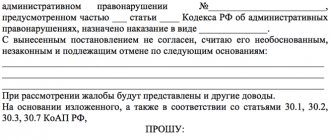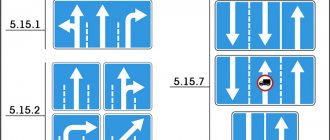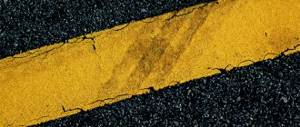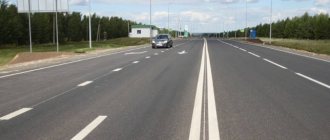Violations related to crossing road markings in the form of a solid line are a very common administrative violation.
Whether it is done intentionally or out of ignorance does not matter, the responsibility is the same, since it is strictly prohibited.
With this violation, there are many controversial situations; let’s further consider what they are and what fines are provided for this.
Before reading the article further, look at what road markings 1.1 look like.
Horizontal layout 1.1:
What is the fine for crossing marking 1.1 in one direction?
The set of provisions that regulates fines and other types of punishment for administrative offenses is regulated by the Code of Administrative Offenses of the Russian Federation.
According to part one of Article 12.16 of the Administrative Code, driving through a solid line in the same direction without complying with the requirements of road markings 1.1 entails a warning or a fine of 500 rubles .
For example . On a 4-lane road, the driver of a passenger car (A) decided to overtake a cargo vehicle (B) in front of the bridge. To the left of it is a horizontal marking 1.1, indicating the prohibition of crossing. Driver A crossed the solid marking line while passing! direction, but he committed this action in violation of traffic rules. Therefore, he will face punishment in accordance with Part 1 of Art. 12.16 Code of Administrative Offenses of the Russian Federation.
When turning through a solid lane 1.1 in order to change lanes in another direction from 1000 to 1500 rubles, Art. 12.16, part 2.
Penalty for crossing a solid line 1.1
The amount of the fine for crossing a solid line marking 1.1 will depend on the circumstances in which this marking is crossed.
Crossing the “center” solid line on a two-lane road is equivalent to entering the lane of oncoming traffic. This can happen in two cases: when overtaking and when going around an obstacle.
For avoiding an obstacle in the oncoming lane through a solid line 1.1, a fine is provided under Article 12.15 Part 3 of the Administrative Code in the amount of 1000 - 1500 rubles.
For overtaking (overtaking maneuver = the fact of driving into the oncoming lane, paragraph 1.2 of the traffic rules) through the solid line 1.1, if this is the first violation, a fine of 5,000 rubles is imposed. (with automatic recording on camera) or deprivation of rights for up to six months. A repeated violation will result in deprivation of rights for 1 year or a fine of 5,000 rubles if it is recorded by a camera (Article 12.15, Parts 4, 5 of the Administrative Code).
For crossing the solid line 1.1 separating the passing lane for route vehicles, a fine is provided under Article 12.17 of the Code of Administrative Offenses in the amount of 1,500 rubles. If this violation was committed in Moscow or St. Petersburg, the fine will be 3,000 rubles.
For crossing markings 1.1 in other cases, for example, when changing lanes into a passing lane separated by a solid line, for turning through a solid line, a fine may be imposed under Article 12.16 Part 1 of the Code of Administrative Offenses in the form of a warning or 500 rubles.
What is written in the traffic rules?
In order to avoid warnings and fines for crossing a solid line in the same direction, you must strictly adhere to the Traffic Rules.
The main points of the traffic rules regarding the intersection of solid lanes:
- Clause 9.1(1). On any two-way roads, driving in the lane intended for the oncoming direction is prohibited if it is separated by tram tracks, a dividing strip, markings No. 1.1, 1.3 and 1.11.
- Clause 9.2. When driving two-way traffic on roads that have four or more lanes, when passing or overtaking, it is prohibited to enter the lane along which oncoming traffic is taking place.
Purpose of demarcation strips
Reference: demarcation stripes refer to horizontal road markings. Their main purpose can be judged directly by their name - this type of marking is designed to divide the road surface into lanes and zones.
Boundary strips include:
- Single continuous strip , its purpose is to separate traffic flows in opposite directions and mark the boundaries of traffic lanes in dangerous places on the roads. Indicates the boundaries of the roadway where entry is prohibited, and also demarcates parking spaces. In the traffic rules of the Russian Federation it is listed under number 1.1. It can be permanently white, temporary – orange. The latter is used during construction or repair work.
- A solid line in the same direction is a demarcation strip, which is usually applied to systematize the flow of vehicles in one direction. Such a line can be seen in tunnels, on bridges, when approaching an intersection.
- A double solid lane is used when there are more than 4 or more lanes on the road. In the traffic rules of the Russian Federation it is listed under number 1.3. Read about the driver's responsibility when crossing a double line in this article.
- A single solid stripe with a dotted line on the left side - to indicate places where changing lanes is allowed only on one side (No. 1.11).
- Thick solid strip - used to mark the edge of the roadway (No. 1.2). A solid line may also indicate the boundaries of the parking zone.
The photo shows markup 1.1:
Below is a photo of markup 1.3:
Below you can see a photo of the 1.11 markup:
Check out the photo of markup 1.2:
Markup 1.2
June 7, 2013 Administrator Home page » Road markings Views:
In the last comment we touched on the most insidious line of horizontal road markings, calling it “single solid”. But in the rich arsenal of traffic control means, there is another “single continuous” marking line. However, its digital designation is not 1.1, but 1.2.
Unfortunately, it happens that drivers confuse these two horizontal markings, which are completely different in meaning and principles of operation. Let's try to figure it out. And for this purpose, we will give a specific example of the simultaneous use of these two types of markup.
As can be seen from the figure, the first obvious difference, visible even to the naked eye, is the place where the markings are applied.
Marking 1.1 delimits traffic lanes (in this case, for traffic in opposite directions). Therefore, “single continuous” markings 1.1 are used “INSIDE” the roadway.
But marking 1.2 is applied “OUTSIDE” - along the edge of the roadway - and indicates the place where the roadway actually ends. Most often, these markings separate the roadway and the side of the road. (By the way, this is why marking 1.2 is called the “edge line”).
One more question is very important for the driver: IS IT POSSIBLE TO CROSS the “single solid” marking line 1.2?
In principle, the Rules prohibit crossing this marking line. However, “single continuous” 1.2 can be crossed to stop and park a vehicle, as well as to exit from the side of the road onto the roadway after they have been completed.
The only condition is that there is no ban on stopping and parking on this section of the road.
Let's look at a specific example.
The legality of stopping (or parking) in place B is beyond doubt. In accordance with the requirements of the Rules (section 12), stopping and parking can be done on the right side of the road - on the side of the road.
That is why the driver of the vehicle has every right to cross the solid marking line 1.2 and stop in position B.
But in case A - also behind the solid marking line, but on the dividing strip - stopping and parking are strictly prohibited. That is why the driver in this case is prohibited from crossing this “single continuous road”.
Summarize. A “single solid” marking line 1.2 is used to mark the edge of the carriageway. It is strictly forbidden to cross it while driving, but it is allowed to stop and park if they are not prohibited by the Rules on this section of the road.
If this information was useful to you, please write about it in the comments. If you have any questions, write, I will definitely try to help you.
Traffic regulations online from the autoass team!
The content of the article:
- marking 1 2 1
- marking 1 2
- Is it possible to cross a solid line on the side of the road?
- road markings 2015 with explanations
Tags: markup 1.2.1
Errors when crossing a solid line
- Changing lanes in a different direction. A situation that occurs quite often on our roads. The driver, without waiting for an intersection or a turn, an intermittent line, hurries to change the direction of movement and crosses a solid line. Let us remind you that for such an act he will face a fine ranging from 1000 to 1500 rubles. according to Art. Code of Administrative Offenses 12.16, part 2.
- Attempt to overtake. The driver, neglecting traffic rules, overtakes, enters the oncoming lane and crosses the solid lane 1.1. For such a violation in accordance with Part 4 of Art. 12.15 Code of Administrative Offenses will be 5,000 rubles or deprivation of rights for crossing a continuous road for 4-6 months.
- An attempt to avoid an existing obstacle. Often, drivers encountering obstacles on the roads in the form of broken down cars, repair work, cross a continuous lane into the oncoming lane. This administrative violation is subject to punishment, which is regulated by Part 3 of Art. 12.15 Code of Administrative Offenses - a fine of 1000-1500 rubles.
Important: it doesn’t matter what is being crossed - a double and a single solid line are equivalent markings, the intersection of which is strictly prohibited.
Continuous markings before the intersection - is it possible to cross when changing lanes?
Every driver knows that crossing the solid marking line that separates the oncoming and oncoming lanes is prohibited. However, on the road you can often find similar markings that separate lanes in one direction. For example, very often before intersections. Not all motorists know whether it is possible to cross it.
The use of a solid line that separates passing lanes has only recently begun. As a rule, its length is 10-15 meters. The authorities decided to implement such a solution for a reason. If you look at the situation in large cities at intersections, you can see what kind of traffic jams and accidents are created there when someone tries to move to another lane right at the traffic light. For example, a driver is standing in the left lane and suddenly remembers that he needs to turn right. In this case, many make thoughtless decisions that can cost human lives.
The driver does not always cross the solid road at an intersection in order to avoid a traffic jam. Very often, when turning left, some motorists turn on the turn signal at the very last moment. A person may stand behind them and need to continue moving straight. Then he sees that the opportunity to calmly continue moving disappears - he has to squeeze into another row. These are the most common situations. In practice there are many times more of them. Under such circumstances, a motorist crosses a solid marking line, thereby breaking the rules. But is there a penalty for this?
Let’s answer the question posed right away - crossing solid markings is not allowed under any circumstances, even if it separates passing lanes. Very often such markings can be found inside tunnels or on bridges and near traffic lights. In each of these cases, you cannot cross it. Let us remember what punishment is provided for a driver who simply crossed a continuous line and went into the oncoming direction. The law provides for a fine of 5,000 rubles or deprivation of rights for such an act. However, such punishment does not apply to those drivers who cross the solid marking line separating passing lanes.
Part 1 of Article 12.16 of the Code of Administrative Offenses of the Russian Federation states that for such an action there is a fine of only 500 rubles - a noticeable difference, right? These are the sanctions that are imposed on motorists who at the last moment want to change lanes at an intersection. Note that today compliance with such rules is monitored not only by traffic police officers, but also by traffic cameras, which are installed at almost every intersection.
Bottom line . Crossing a solid road before an intersection - what is the penalty? Unlike cases of driving into the oncoming lane, the driver will be fined only 500 rubles for such an act. Before each traffic light, you need to get into the right lane in a timely manner so as not to empty your pocket and not create problems for other road users.
Controversial issues and ways to avoid punishment
The most common controversial situations, as well as ways to avoid punishment in them, are:
As we see, in many controversial issues it is possible, if not to completely avoid punishment, then to minimize the cost of fines. And if you pay within 20 days after receiving the decision, the driver will be able to count on discounts when paying the fine.











